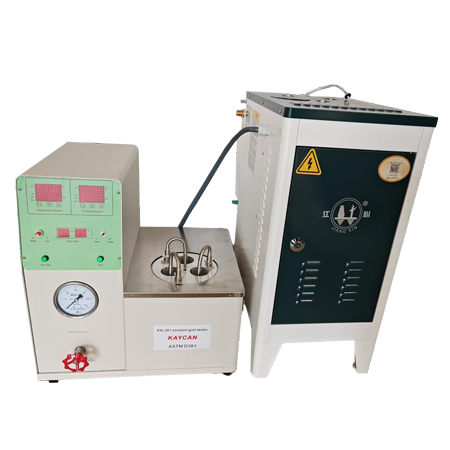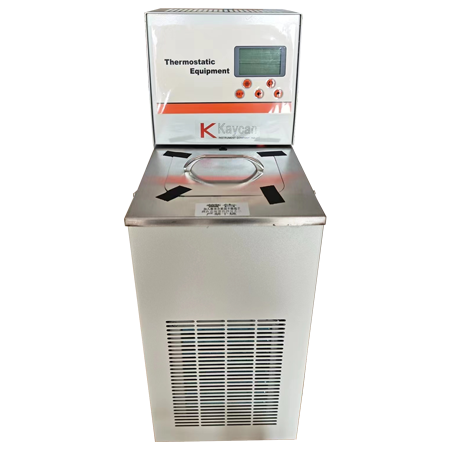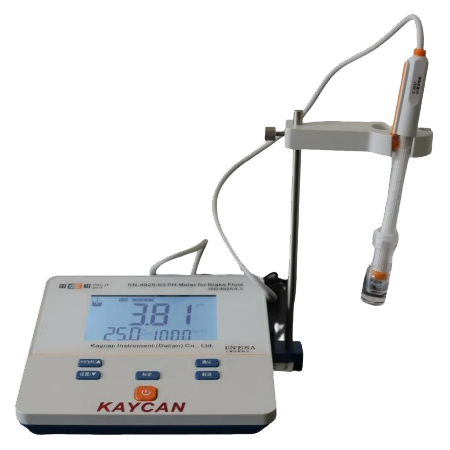-
ASTM D6421 Apparatus for Electronic Port Fuel Injector Fouling by Bench Procedure
KN-6421 Apparatus for Electronic Port Fuel Injector Fouling by Bench Procedure conforms to ASTM D6421 Standard Test Method for Evaluating Automotive Spark-Ignition Engine Fuel for Electronic Port Fuel Injector Fouling by Bench Procedure. This test method covers a bench test procedure to evaluate the tendency of automotive spark-ignition engine fuel to foul electronic port fuel injectors (PFI). The test method utilizes a bench apparatus equipped with Bosch injectors specified for use in a 1985-1987 Chrysler 2.2-L turbocharged engine. This test method is based on a test procedure developed by the Coordinating Research Council (CRC) for prediction of the tendency of spark-ignition engine fuel to form deposits in the small metering clearances of injectors in a port fuel injection engine.
Send Email Details -
ASTM D381 Existent Gum Content Tester
KN-381 Existent Gum Content Tester (Steam Method) conforms to ASTM D381 Standard Test Method for Gum Content by Jet Evaporation. When testing either aviation or motor gasoline, a 50±0.5ml quantity of fuel is evaporated under controlled conditions of temperature and flow of air. When testing aviation turbine fuel, a 50±0.5ml quantity of fuel is evaporated under controlled conditions of temperature an flow of steam. For aviation gasoline and aviation turbine fuel, the resulting residue is weighed and reported as milligrams per 100ml. For motor gasoline, the residue is weighed before and after extracting with heptane and the results reported as milligrams per 100ml.
Send Email Details -
ASTM D381 Existent Gum Content Tester, Air Method
KN-381A Existent Gum Content Tester (Air Method) conforms to ASTM D381 Standard Test Method for Gum Content by Jet Evaporation. When testing motor gasoline, a 50±0.5ml quantity of fuel is evaporated under controlled conditions of temperature and flow of air. For motor gasoline, the residue is weighed before and after extracting with heptane and the results reported as milligrams per 100ml.
Send Email Details -
ASTM D2619 Apparatus for Hydrolytic Stability of Hydraulic Fluids
KN-2619 Apparatus for Hydrolytic Stability of Hydraulic Fluids conforms to ASTM D2619 Standard Test Method for Hydrolytic Stability of Hydraulic Fluids (Beverage Bottle Method). This test method differentiates the relative stability of hydraulic fluids in the presence of water under the conditions of the test. Hydrolytically unstable hydraulic fluids form acidic and insoluble contaminants which can cause hydraulic system malfunctions due to corrosion, valve sticking, or change in viscosity of the fluid. The degree of correlation between this test method and service performance has not been fully determined.
Send Email Details -
Apparatus for Chlorine in Aromatics
KN-7536 Apparatus for Chlorine in Aromatics conforms to ASTM D7536 Standard Test Method for Chlorine in Aromatics by Monochromatic Wavelength Dispersive X-ray Fluorescence Spectrometry. This test method provides for the precise measurement of the chlorine content of aromatics with minimal sample preparation and analyst involvement. The typical time for each analysis is five or ten minutes. Knowledge of the chlorine content of aromatics is important for process control as well as the prediction and control of operational problems such as unit corrosion and catalyst poisoning, and in the blending of products to commodity specifications. Various federal, state, and local agencies regulate the chlorine content of some petroleum products, including aromatics. Unbiased and precise determination of chlorine in aromatics is critical to compliance with regulatory standards.
Send Email Details -
ASTM E659 Autoignition Temperature Tester
KN-659 Autoignition Temperature Tester conforms to ASTM E659 Standard Test Method for Autoignition Temperature of Chemicals. A small, metered sample of the product to be tested is inserted into a uniformly heated 500ml glass flask containing air at a predetermined temperature. The contents of the flask are observe in a dark room for 10min following insertion of the sample, or until autoignition occurs. Autoignition is evidenced by the sudden appearance of a flame inside the flask and by a sharp rise in the temperature of the gas mixture. The lowest internal flask temperature at which hot-flame ignition occurs for a series of prescribed sample volumes is taken to be the hot-flame autoignition temperature of the chemical in air at atmospheric pressure. Ignition delay times (ignition time lags) are measured in order to determine the ignition delay-ignition temperature relationship.
Send Email Details -
ASTM D8288 Automatic Tapping Torque Testing System
KN-8288 Automatic Tapping Torque Testing System conforms to ASTM D8288 Standard Test Method for Comparison of Metal working Fluids Using a Tapping Torque Test Machine. This test method can be used to predict the comparative lubricating properties of a metalworking fluid (MWF). Fluids that produce lower torques or higher efficiencies are predicted to have better machining characteristics. The method is applicable to all tap types, machining speeds, alloys and coatings that can be fabricated into a test piece. Comparison between different operating conditions or various types of fluids can be made. The reportable quantity is the efficiency or mean average torque of a reference fluid divided by the mean average torque of the fluid of interest.
Send Email Details -
KN-SY Circulating Water Bath
KN-SY Circulating Water Bath can be widely used in drying, concentration, distillation, impregnated chemical reagents, impregnated drugs and biological products, and can also be used for constant temperature heating in water baths and other temperature tests, and is an essential tool for biology, genetics, viruses, aquatic products, environmental protection, medicine, health, biochemical laboratories, analysis rooms, education and scientific research.
Send Email Details -
GOST 7143 Ultimate Strength and Thermostrengthening Tester
KN-7143 Ultimate Strength and Thermostrengthening Tester conforms to GOST 1743 Greases. Method for Determination of Ultimate Strength and Thermostrengthening. It is mainly used to measure the pressure of the grease when it is displaced in the threaded pipe of the plasticizer at the test temperature, and convert it into a strength limit value, which is expressed as Pa. The appearance design of the grease strength limit tester is beautiful and generous, the structure design is reasonable, the operation is convenient, and the results are accurate
Send Email Details -
ASTM D1287 PH Meter
KN-1287 PH Meter conforms to ASTM D1287 Standard Test Method for pH of Engine Coolants and Antirusts and ASTM D1121 Standard Test Method for Reserve Alkalinity of Engine Coolants and Antirusts. pH is a measure of the hydrogen ion concentration and indicates whether an engine coolant, or a solution of these compounds is acidic, alkaline, or neutral. The pH range includes values from 0 to 14. Values from 0 to 7 represent the acidic half of the scale. Values from 7 to 14 represent the alkaline or b
Send Email Details -
ASTM D4059 GC for PCBs in Insulating Liquids
KN-4059 GC for PCBs in Insulating Liquids conforms to ASTM D4059 Standard Test Method for Analysis of Polychlorinated Biphenyls in Insulating Liquids by Gas Chromatography. This test method describes a quantitative determination of the concentration of polychlorinated biphenyls (PCBs) in electrical insulating liquids by gas chromatography. It also applies to the determination of PCB present in mixtures known as askarels, used as electrical insulating liquids.
Send Email Details -
ASTM D7843 Membrane Patch Colorimetry
KN-7843 Membrane Patch Colorimetry conforms to ASTM D7843 Standard Test Method for Measurement of Lubricant Generated Insoluble Color Bodies in In-Service Turbine Oils using Membrane Patch Colorimetry. Insoluble deposits are extracted from an in-service turbine oil sample using a 47mm, 0.45μm membrane nitrocellulose patch. The color of the patch is then analyzed using a spectrophotometer and the results are reported as a △E value in the CIELAB scale.
Send Email Details
















